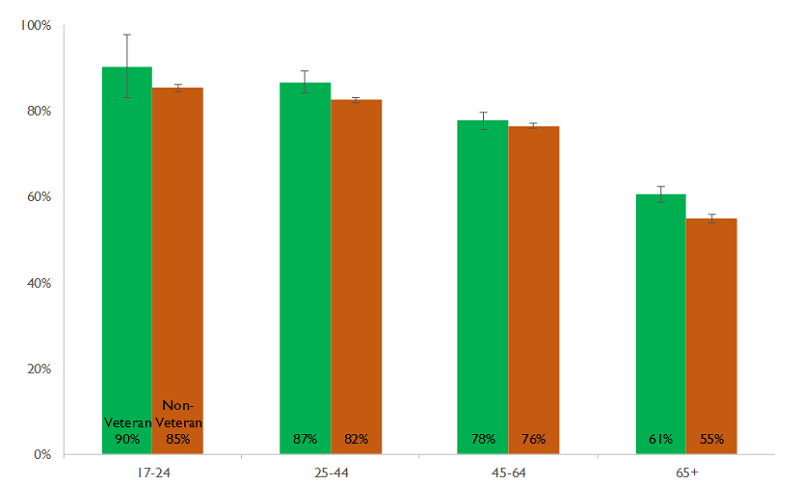Fact Sheet: Veterans’ Computer and Internet Use
Since 1994, NTIA has partnered with the U.S. Census Bureau to survey American households on their computer and Internet use, with questions that have been updated over time to reflect changing technologies and applications. We ask about locations of Internet use, devices people use to go online, the types of online activities in which they take part, their views on privacy and security, and why some do not use the Internet. The data provide substantial demographic information, including household income, education level, race, disability status, veteran status, and rural or urban residence.
Our most recent survey was conducted in July 2015, and the next survey will be conducted in mid-November 2017, with results available in spring 2018. Because NTIA’s survey is administered as a Supplement to the Current Population Survey (CPS), it benefits from that survey’s sophisticated methodology and large sample size—which includes roughly 53,000 households and 120,000 individuals. The CPS Computer and Internet Use Supplement is the most comprehensive survey of computer and Internet use in the U.S., including among the veteran population, and it serves as the main data source behind all of NTIA’s Digital Nation research. Our 2015 survey sample included 8,654 veterans.* Here are some top-level findings on veterans’ computer and Internet use:
- NTIA statistical analysis suggests that veterans are 1 to 2 percentage points more likely to use the Internet than their non-veteran peers when accounting for a range of demographic characteristics. We came to this conclusion by employing a statistical technique known as multivariate regression analysis; we constructed a model predicting Internet use as a function of veteran status and a number of other factors with known links to Internet use, such as age, income, and education.
- Veterans are demographically distinct from the overall U.S. population. The average age of veterans (61 years) is considerably older than that of non-veterans (45 years), and 16 percent of veterans live in rural areas, as opposed to 13 percent of non-veterans. Further, veterans are about twice as likely to be disabled (24 percent) as non-veterans (11 percent). Only 45 percent of veterans were employed in 2015, compared to 62 percent of non-veterans (over half of veterans, 52 percent, are retired or otherwise not in the labor force). NTIA has previously shown that all of these factors contribute to individuals and households not using the Internet. Veterans, however, are considerably more likely to possess at least a high school diploma than their non-veteran counterparts; only 6 percent of veterans lacked a high school diploma in 2015, compared with 13 percent of non-veterans.
- Controlling for age, veterans are more likely than their non-veteran peers to use the Internet. As shown in Figure 1, veterans between the age of 25 and 44 are 5 percentage points more likely to go online than non-veterans in the same age range, and veterans 65 and older are 6 percentage points more likely to go online than their counterparts.
- Veterans are slightly less likely to go online either at home or at any location when directly compared with the U.S. population. In 2015, 66 percent of veterans used the Internet at home, as compared with 71 percent of non-veterans. And 71 percent of veterans used the Internet from any location, as compared to 76 percent of non-veterans. This divide has been consistent over time, ranging from a 4 to 6 percentage point difference since at least as far back as 2010. This data point doesn’t tell the whole story, however, because factors such as older age, rural residence and having a disability are correlated with lower levels of Internet use, independent of veteran status.
- Veteran-led households that do not go online at home are more likely to say they do not need or are not interested in the service than non-veterans and less likely to say they cannot afford it. This could be an indication that getting more veterans online will require a unique form of outreach and education. It is also consistent with the older age distribution of veterans compared with their peers.
- Veterans make up nearly 8 percent of the U.S. civilian population aged 17 years or older, according to the CPS. Since the military has been downsizing since around 1970, the veteran population is disproportionately older. This suggests that the rate of Internet adoption among veterans is likely to increase over time.
For a more detailed look at veterans’ Internet use, NTIA could potentially merge its Digital Nation data with the CPS Veterans Supplement to examine how Internet use relates to periods of service, service-connected disabilities, and participation in certain veteran-specific educational or job-training programs. To learn more about veterans’ Internet use and see all of NTIA’s data and analysis about computer and Internet use in the U.S., visit the Data Central hub on NTIA’s website.
Figure 1: Internet Use at Any Location by Age Group and Veteran Status Percent of U.S. Civilians Ages 17+, 2015

* The CPS identifies veterans as anyone who answers yes to the question “Did you ever serve on active duty in the U.S. armed forces?” This suggests that anyone who has completed basic military training would be considered a veteran. Since those currently on active duty are excluded from the CPS, they are not included in the results of the survey.
